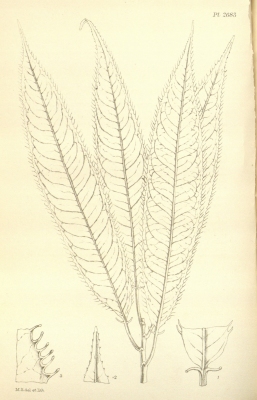Sapium ciliatum
Hemsl.
Euphorbiaceae
Common Name:
General Information
Sapium ciliatum is an evergreen tree growing around 5 metres tall.
The tree is harvested from the wild for local use as a medicine, and possibly also for its wood, which would be traded.
Known Hazards
None known
Botanical References
Range
S. America - northern Brazil, French Guiana, Surinam.
Habitat
Not known
Properties
| Medicinal Rating |      |
| Other Uses Rating |      |
| Habit | Evergreen Tree |
| Height | 5.00 m |
| Cultivation Status | Wild |
Cultivation Details
Not known
Edible Uses
None known
Medicinal
The bark of the trunk contains a latex that is made into a decoction and used as an external wash for fever[
348- Title
- Medicinal Plants of the Guianas
- Publication
-
- Author
- DeFilipps, R. A.; Maina, S. L.; & Crepin, J.
- Website
- http://botany.si.edu/bdg/medicinal/index.html
- Publisher
- Smithsonian Museum
- Year
- 0
- ISBN
-
- Description
- A down-loadable PDF document of a book in pre-publication awaiting illustration. An excellent, if rather terse, guide to the traditional medicinal uses of the plants of the region
].
Other Uses
A latex is obtained from the tree that can be used to make rubber348]. Before the advent of synthetic rubber, and the dominance of Hevea brasiliensis for producing natural rubber, this was one of many species that were believed to be possible commercial sources of latex for producing rubber. At the present time we can only find information on its medicinal use[
K- Title
- Plants for a Future
- Author
- Ken Fern
- Description
- Notes from observations, tasting etc at Plants For A Future and on field trips.
].
We have no information on the wood for this species, but a general description of the wood from American members of the genus is as follows:-
The heartwood is whitish, yellowish, or light brown; it is not distinct from the cream-coloured sapwood. The texture is medium; the grain straight to slightly interlocked; lustre is low; there is no distinctive odour or taste. The wood has a low resistance to decay and insect attack, including dry-wood termites; lumber is particularly prone to blue stain. The wood is reported to air dry rapidly with only slight warping and checking. It works easily because of its low density; sometimes surfaces are fuzzy but it generally machines smoothly; one report indicates a difficulty in sanding. It is used for purposes such as plywood, fiberboard, particleboard, general carpentry, millwork, utility furniture, boxes and crates[
316- Title
- Tropical Timbers of the World. Ag. Handbook No. 607.
- Publication
-
- Author
- Chudnoff. Martin.
- Publisher
- USDA Forest Service. Wisconsin.
- Year
- 1984
- ISBN
-
- Description
- Terse details on the properties of the wood of almost 400 species of trees from the Tropics.
].
Propagation
Seed -
If you have any useful information about this plant, please leave a comment. Comments have to be approved before they are shown here.


 Useful Tropical Plants Database 2014 by
Ken Fern,
web interface by
Ajna Fern
with help from
Richard Morris.
Useful Tropical Plants Database 2014 by
Ken Fern,
web interface by
Ajna Fern
with help from
Richard Morris.